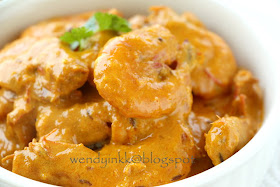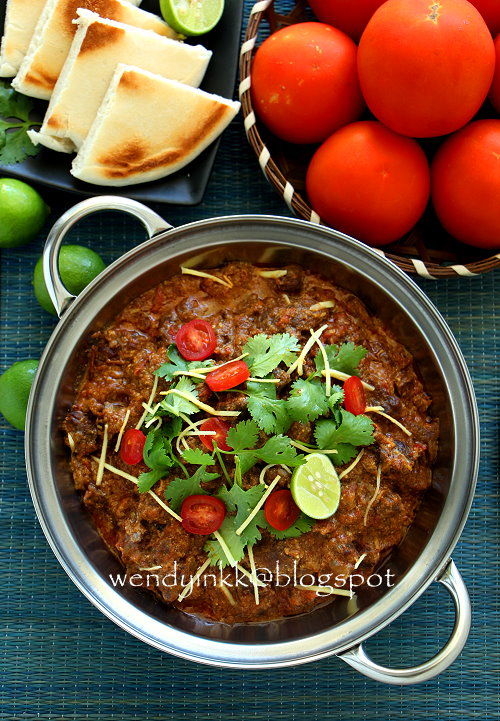Pages
▼
Thursday, May 29, 2014
Monday, May 26, 2014
Mishti Pulao - AFF Indian Rice Dishes #1
Mishti is sweet is Bengali. Mishti Pulao simply meant, sweet rice.
It might sound funny to you to eat a sweet tasting rice.... but not really. The sugar here nicely offsets the pungency of the turmeric and it's just mildly sweet, like how we enjoy the taste of coconut rice. The list of spices is not long, and they are easily available.
Friday, May 23, 2014
Creamy Prawn Curry @ Chingri Malaikari @ - AFF Indian Subcontinent #10
I love love love this prawn dish! And I'm going to repeat this dish quite often in the future. It's very nice.
After I cooked this dish, I realized why this is a dish that Bongs will serve whenever they have guests. It's because it is easy and delicious!
Frying the prawns before adding to the gravy is a lovely step to add flavour. Just like Cantonese way of cooking prawns, we like to give the prawns a high heat searing or a quick deep fry to enhance the flavour. And don't leave out the shells. That's where the flavour is. If you sear it with or without the shells, the fragrance will be obviously different. And to see this technique applied to this prawn curry is really an eye opener.
In Bangladeshi restaurants, it's usually cooked with large prawns or lobsters, shell on. But since I have some medium prawns, I just used that. Some recipes didn't mind using smaller prawns and some even use the prawn flesh only, without any shells at all.
I cooked this dish with reference to two recipes, taking some part from this and some part from that. I prefer cumin over coriander and I prefer red chilli powder over fresh green chilli. The rest pretty much remains for both recipes.
Mustard oil is an important ingredient when it comes to cooking seafood in Bangladesh, and I substituted it with oil flavoured with mustard seeds. I know it could be different, but that's the best that I can do.
I'm really glad I tried out this dish.
Creamy Prawn Curry Bangladeshi Style
Reference: Food Punch and My Saffron Kitchen
300gm prawns
1/4 tsp salt
pinch of turmeric
1 tsp mustard seeds
3 Tbsp oil
1cm ginger
1 small onion
1 inch cinnamon
3 cloves
1/2 tsp cumin seeds
1 small Indian bay leaf
1 tsp chilli powder
1/2 tsp turmeric powder
150ml coconut milk
100 ml water
1. Clean prawns and marinate with salt and turmeric.
2. Grate or grind ginger and onion to a paste.
3. Heat wok/pan and put in 3 Tbsp oil. Put in mustard seeds and let them cook until they sputter. Turn off the heat and remove the seeds*.
4. On high heat, sear the prawns until they curl up. Push them to the side, and let excess oil drip down into the wok.
5. With the same oil and wok , on medium low heat, saute cinnamon, cumin and cloves first, for a few seconds. Add in ginger and onion, and saute until it looks glossy. Add in chilli powder and turmeric powder and cook for around 10 seconds.
6. Add in water and coconut milk. Stir it gently all the while. Add in some salt to taste and cook until the gravy reaches your preferred consistency
7. Add in the prawns and bring it back to a boil. Turn off the heat and dish up.
* I sprinkled the fried mustard seeds onto some stir fried cabbage. No wastage.
I am submitting this to Asian Food Fest Indian Subcontinent Month,
hosted by Alvin of Chef and Sommelier
Wednesday, May 21, 2014
Monday, May 19, 2014
String Hopper Biryani - AFF Indian Subcontinent #8
A biryani not made with rice..but a rice product, the delicious idiyappam or string hoppers or putu mayam.
It is a specialty from Sri Lanka, and no two recipes are the same.
Usually we see biryani that is made with rice... and takes a lot of ingredients, spices and time ..but not this special biryani. It's like cooking fried rice!
 |
| first attempt |
I cooked this twice, because I wasn't happy with the first attempt's pictures. The morning sun was too bright on my patio. When I made it the second time, I ran out of carrots. Haha. So, you will see both plates of string hopper biryani looking slightly different.
You can make this with store bought idiyappam, but I used homemade ones, hence they look fatter, almost like broken bits of basmati rice.
I tried this recipe for breakfast and it was so yummy! If you don't want to use string hoppers, I think you can just usecooked rice. The texture will not the same, of course, but the taste of the ingredient combination is nice, and it won't be string hopper biryani anymore.
 |
| 2nd attempt |
String Hopper Biryani
Reference: Sarojini's Sri Lanka Food
Single portion
String hoppers for 1 person
2 Tbsp coconut milk
1 knob of butter ( around 20gm)
1 smallish piece of cinnamon
1 clove
1 cardamom, crushed until crack
1/2 sprig curry leaf
2 inches pandan leaf, torn into 4 pcs
1 tsp grated garlic
1/2 tsp grated ginger
1 smallish red onion, thinly sliced
2 Tbsp carrots, cut into 1 inch thin matchsticks
10 small prawns, marinated with Pinch of salt + Pinch of chilli powder
Garnish
Omelette
Cashew nuts
Raisins
Coriander
1. Moisten string hoppers with coconut milk. Lightly break it up.
2. Heat a frying pan and fry the omelette. Let it cool down and slice.
3. With the same pan, add in 1 Tbsp oil and heat it up. Put in prawns and sear it until golden and curled up. Remove the prawns and keep the pan.
4. Lower the heat to medium and put in butter. Put in cinnamon, clove and cardamom and fry it for a few seconds until fragrant.
5. Add in ginger and and garlic and saute until fragrant, then add in onions and cook until translucent and very lightly browned. Add in carrots and cook until wilted.
6. Add in curry leaf and pandan leaf and cook for a few seconds, until you can smell the fragrance.
7. Pour in the moistened string hoppers, add salt to taste (I used 1/4 tsp). Toss the string hoppers around until well incorporated.
8. Dish up and garnish with the cooked prawns, omelette strips, cashew nuts, raisins and coriander.
I am submitting this to Asian Food Fest Indian Subcontinent Month,
hosted by Alvin of Chef and Sommelier
Friday, May 16, 2014
Ribbon Pakoda - AFF Indian Snacks #2
Now.... my college of Indian ethnicity got a shock when I showed her my ribbon pakodas. To her pakodas don't look like this, hehehe. And even my omapodi that I posted on Monday, she told me omapodi here is usually made much thicker. After some discussion with her... even murukkus are different. We love adding coconut milk to the dough. Hahaha. But it's not common in India.
Wednesday, May 14, 2014
Seepu Murukku - AFF Indian Snacks #2
Seepu Murukku or Seepu Seedai is a ring shaped snack. The word seepu means comb and the traditional method of forming the lines is by using a comb. See here.
But newer methods nowadays uses a dough press, that is similar to the ones we use for pineapple rolls or nastar. It definitely makes life easier.
Monday, May 12, 2014
Omapodi - AFF Indian Snacks #1
Mamee Monster noodle snack is a popular junk food in Malaysia. Most kids like it and not forgetting ex-kids like my hubby and I too.
This will be a better choice than factory made snacks. Made with protein rich chickpea flour and spices that aid digestion, it's a snack that you can consider making. Despite it being fried, my omapodi didn't feel oily.
Friday, May 9, 2014
Punjabi Chole Masala AFF Indian Subcontinent #5
It's a lovely condiment.
Spicy and fragrant.
It's quite easy to cook, because I used canned chickpeas. Cheating...haha.
Wednesday, May 7, 2014
Rava Dosa - AFF Indian Subcontinent #4
I have only eaten this once at a local mamak eatery and I love the texture of the semolina in it. Locally, they pronounce it as Rawa Thosai (toh-say)
It's not the same as the usual dosa (thosai) that is slightly sourish made with rice and gram. This dosa is not fermented and hence, doesn't have that tang that one might usually equate with dosa. The batter only needs 1 hour of waiting time, so that the semolina can absorb some moisture and the flour will form some gluten.
Monday, May 5, 2014
Idiyappam @ Putu Mayam - AFF Indian Subcontinent #2
This week is all about breakfast..but you can eat these anytime of the day if you wish.
Idiyappam or String Hoppers is something like rice vermicelli that is made fresh for consumption. It is known in Malaysia as Putu Mayam. Idiyappam is a culinary specialty of Kerala,Tamil Nadu and southern areas of Karnataka. It is also a culinary staple in Sri Lanka.
It's a childhood favourite of mine, and still is one of my favourite things to eat. Being able to make this at home really makes my heart jump as I can have it as often as I like.
Thursday, May 1, 2014
Garam Masala - AFF Indian Subcontinent
Garam masala is a blend of spices and there are no fixed rules to it.
Garam means salt in Malay Language, but for the Indian cuisine, it meant "hot" and masala meant "spice" in Hindi. The composition of the spice blend depends on the region and personal taste, every household will have their own special mix of spices, toasted and ground to a fine powder.


















